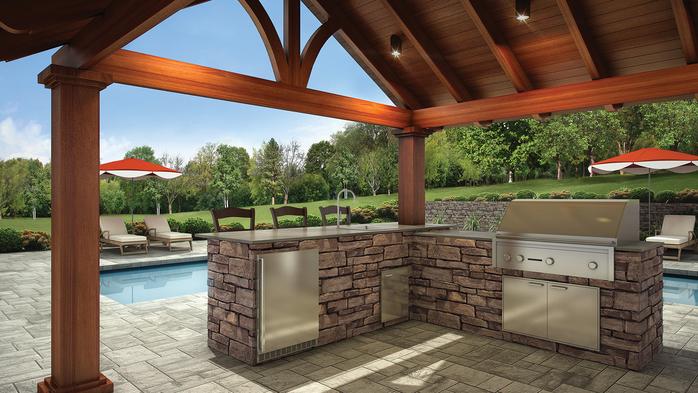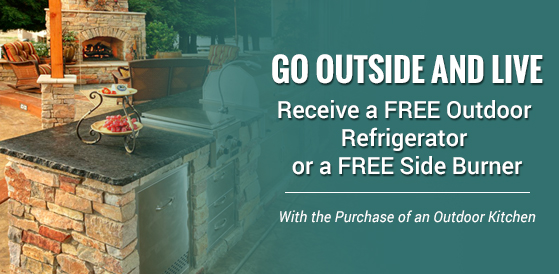3 Must-Have Features Every Outdoor Kitchen Needs
There’s no doubt that people love the outdoors, which is why we have seen a big increase in the popularity of outdoor kitchens. Cooking outside has now evolved passed just firing up the grill for some hamburgers. Now you can have a full outdoor kitchen filled with every amenity you could possibly imagine.
Upgrading your barbecue area to an outdoor kitchen will increase your home’s value and make your home more enjoyable. But before you start making any changes, you need to create a list of the essentials and nonessentials for your outdoor kitchen. To help you out, we’ve put together a list of 3 must-have features every outdoor kitchen needs:
1. Grill
A grill is the most crucial component of any outdoor kitchen. This is the one area you don’t want to skimp on, because this is what you will use the most. Every person has their own preferences when it comes to grills. Guys tend to get excited about the bells and whistles of grills. They see special features as a must-have, such as side burners and infrared technology.
You definitely want to think about how often you will use your grill and how many people you will try to feed. A 36-inch grill can be perfect for most families, but it just depends on what you prefer.
In some people’s minds, several different types of grills are essential for your outdoor space. Sometimes you want gas, sometimes charcoal, and sometimes wood-pellet. A smoker is also deemed an essential on many lists. You’ve probably heard of popular brands such as Weber and Saber, which are known for their durability and dependability. Kamado Joe grills are the ultimate in ceramic grilling and known for their versatility.
The key is to not settle. Buy the best grill you can possibly afford, because it will be worth it in the long run.
2. Work Space
 An outdoor kitchen should be divided into four zones: hot, dry, wet, and cold. The hot zone includes your grills, cooktops, pizza ovens, and the like. The dry zone should be your main counter space used for food prep, plus cabinets and other storage space. The wet zone includes your sink plus adjacent counter space. The cold zone includes refrigerators, freezers, wine coolers, and any other cold storage space.
An outdoor kitchen should be divided into four zones: hot, dry, wet, and cold. The hot zone includes your grills, cooktops, pizza ovens, and the like. The dry zone should be your main counter space used for food prep, plus cabinets and other storage space. The wet zone includes your sink plus adjacent counter space. The cold zone includes refrigerators, freezers, wine coolers, and any other cold storage space.
Dividing your outdoor kitchen in work spaces makes it easier to prep, cook, serve and cleanup. You should plan enough space for all four functional zones, including plenty of countertop space.
Designers typically suggest at least 12 inches of work space on either side of the cooking surface. The more space the better in an outdoor kitchen; after all, you want plenty of room to accomplish multiple tasks plus room for others to gather around while you cook.
Just like you shouldn’t skimp on a grill, you shouldn’t skimp on space either. Just be sure to check local zoning laws regarding size and location of your outdoor kitchen.
3. Seating
The grill might be the heart of an outdoor kitchen, but seating is a close second. Seating allows people to gather around while you are cooking, allows you to eat outside, and allows you to relax after a delicious meal.
Adding a high bar with barstools off the prep station encourages people to sit and chat while you are grilling out. A large, outdoor dining table can add an elegant touch to your space. It also gives a big crowd the flexibility to eat outside while keeping the comfort you desire.
Make sure your outdoor seating is weather-resistant to ensure it can withstand any type of weather. You also want to consider shading at least part of your outdoor kitchen, particularly the seating. Adding an awning, umbrella, or pergola can make eating outside more enjoyable especially on those hot summer days.
Images courtesy of Eldorado Outdoor
If you are ready to get started on your outdoor kitchen project, we at G&B Energy and our friends at Designcast Concrete are here to assist you! To encourage people to “Go Outside and Live,” we are offering great promotions on outdoor kitchen and living spaces for Spring 2015! Click below to learn more.



